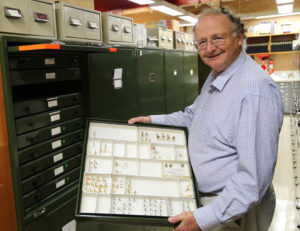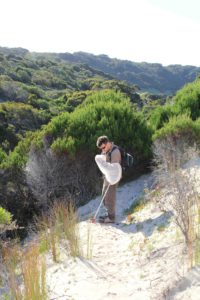These days we tend to think of scientific discovery as being all Large Hadron Colliders, massive telescopes and gene sequencing machines – the sort of technology that Arthur C Clarke famously described as being ‘indistinguishable from magic’.
There’s a special kind of wonder that comes with the Eureka moment of discovery. We usually associate these moments with NASA missions like Voyager 1, still sending back data 19 billion km from earth. Or perhaps the Hubble and Spitzer space telescopes letting us look back in time to see the universe as it was more than 12 billion years ago. And deep sea exploration discovering new animals at the bottom of the Mariana trench.
All this is Big Science – large teams of exceptionally well-funded researchers and eye-wateringly costly equipment. But sometimes small science can make big Eureka discoveries too. Remember the discovery of the Wollemi Pine? Just a bloke with a good eye and a lot of knowledge, tramping through a national park. The story you’re about to read is a bit like that.
We recently celebrated one of the most exciting discoveries in entomology in the last 40 years – the discovery of a new family of primitive moths. It was found right in our own backyard, on Kangaroo Island in South Australia. An island only 100 km from Adelaide and 13 km from the mainland, a place that has been settled since 1836, has been harbouring an insect entirely unknown to science.
Hiding in plain sight
While surveying insects on the island, South Australian scientist Dr Richard Glatz collected two unusual moths. The moths were on Southern Cypress pine-trees (Callitris gracilis) in a remote river valley amongst sand dunes facing the Southern Ocean. These trees, like the Wollemi Pine, are a very ancient element of our flora going back to the supercontinent Gondwana. And like the Wollemi Pine, the moths living in these trees are the equivalent of living dinosaurs.

Because they were unlike any he’d seen before, Richard sent the moth specimens to CSIRO’s Australian National Insect Collection for identification. There, CSIRO Honorary Fellow Dr Ted Edwards quickly realised that the moths probably represented an entirely new group, and sent the specimens to the world’s foremost expert in moths and butterflies, Professor Niels Peder Kristensen at the University of Copenhagen. Ted was right: they were something new.
Of course, Ted is no stranger to discovery. You may have read an earlier ECOS article about the discovery of 11 new species of moth in 2012 – scribbly gum moths. He was part of that too. It’s a wonderful story – the team was made up almost entirely of post-retirement Fellows (one of them well into his 90s) from the Australian National Insect Collection – a sort of grey dream team of entomology.
Discovering a new family though is a really big deal. Families are three rungs from the bottom of the taxonomic ladder – above genera and species. New species and new genera of moths and butterflies are discovered every week, but this is the first time since the 1970s that a new family of primitive moths has been identified.
Primitive moths (defined as those in which females have only a single genital opening) make up less than 1 per cent of existing Lepidoptera species, but a great deal of their morphological diversity (see Note 1). The discovery of a new family of moths tells us about the early steps that led to the evolution of the more typical and familiar moths and butterflies.
Teams of researchers – both professionals and citizen scientists – collected more specimens on visits to the site in 2012 and 2013. So far, though, the moth has only been found in this one location. Searches in other nearby areas of similar habitat have not, as yet, identified other populations.
Meet the family
So let’s meet the Aenigmatineidae family. It contains a single genus (Aenigmatinea) and a single species (Aenigmatinea glatzella). The moth is small, about the size of a five cent piece when its wings are outstretched, and looks more like a caddis-fly than a moth. Although tiny, they are very beautiful: males look as though they’ve been sprinkled with gold dust, females are metallic purple, and both have feathery edges fringing their wings.
The genus name, Aenigmatinea, is well-chosen (it contains the word 'enigma'): there are several puzzling things about this moth that made it difficult to place in an evolutionary framework. Its wings and genitalia showed it to be primitive. The question was how primitive. Even the most primitive moths have jaws, and one of the first steps in the evolution of ‘advanced’ moths and butterflies is the development of a tongue. Aenigmatinea’s mouthparts are almost entirely reduced; it has neither jaws nor tongue.
So the team turned to the moth’s DNA and compared its sequence to potential relatives to determine which species it is genetically closest to. The search delivered a very interesting result – the moth’s closest relatives have a tongue, which indicates that Aenigmatinea lost its tongue over time.

The ‘tinea’ part of the generic name refers to the name Linnaeus gave small moths when he first created his naming system. And glatzella? Well, taxonomists are often very keen on puns. The moth’s head is partially bald, and ‘glatze’ is German for bald head. Glatzella also honours the moth’s discoverer Richard Glatz. Puns can only go so far, though – Dr Glatz has a full head of hair.
Naming new species is not all fun and puns, it serves a fundamental purpose. The name points to where in the tree of life a species sits and so acts as a code unlocking access to scientific knowledge about the species. Naming species is central to what taxonomists and biological collections do, they catalogue life.
Dr Glatz has cause to be grateful he doesn’t resemble his namesake moths in another way - adult moths are short-lived. One day is all they get, and in that time they have to emerge from their cocoons, mate, lay their eggs if they’re female, then die. The eggs are deposited under the small leaves at the tip of the growing branches of Southern Cypress-pine trees. The larvae feed among the pine’s branches before developing into pupae (a transition stage) and then emerging as adult moths.
But that’s not all
Not only was this a great example of collaboration – citizen scientists and professionals working together, and researchers from across the globe as well, it highlights how much more there is to be done. How much more there is to learn.
An estimated 22,000 species of moths and butterflies call Australia home. Only about half of them have been named. As Ted Edwards says, “Our fauna is so exciting we can still find new primitive species. Australia is so rich in moths that vast numbers still remain to be discovered.”
“Collecting and describing our fauna and flora contributes to our understanding of biodiversity, and supports research in evolutionary biology, ecology, biosecurity and natural resource management.”
And with just this one moth, we’ve learned, by studying its appearance and analysing its DNA, that the evolution of moths and butterflies is even more complex than previously thought.
“While the discovery of this new moth strengthens the evolutionary relationships between other primitive moth families, it also suggests that tongues evolved in moths and butterflies more than once,” says Dr Edwards.
So here are some things you can do to help this effort along. Ted's colleague, Marianne Horak, and others have launched a private foundation, Australian Lepidoptera Research Endowment, to support research into Australian moths and butterflies, and the curation of moths and butterflies at CSIRO’s Australian National Insect Collection (ANIC). The fund will support curation, visitors, students, field work and describing new species.
And you can keep an eye out when you’re out enjoying nature. The new species of scribbly gum moths were discovered in Canberra, not somewhere remote, and Kangaroo Island isn’t exactly the back of beyond. With about 11,000 more moths and butterflies still to name and describe, finding something new isn’t that implausible, ANIC is an excellent source of expertise for identifying insects, and citizen scientists are valuable partners.
Who knows? Maybe you could be part of a paper like this one?
View an animation of the newly discovered moth:
NOTES:
- Kristensen, NP & Skalski, AW (1998). “Phylogeny and palaeontology.” In Kristensen, NP. (ed.) Lepidoptera: Moths and butterflies 1. Handbuch der Zoologie/Handbook of Zoology IV/35: 7-25. Walter de Gruyter, Berlin & New York.
